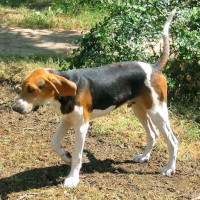Appearance of the Trigg Hound
|
| The Trigg Hound strain tends to be a leaner animal, and they have a rather racy form compared to other American Foxhounds, but still with substantial power. Like most strains or breeds of American Foxhound, it has very strong, straight legs designed to help it keep up with long-legged red foxes on many types of terrain, as well as a powerfully built hindquarters to help it move forward. His head is full and strong, but never heavy or ponderous, and his muzzle is full, a little longer than average, and usually ends in a broad black nose. Its dark eyes are deeper-set than the average dog's, and its long, hanging ears sit low on the head and hang beyond the jaw. Although its short, stiff coat can be any color, only tricolors and bicolors are recognized by hobbyists and breeders. |
Temperament of the Trigg Hound
|
| The Trigg Hound possesses the same intense will to pursue as other American Foxhounds, as well as their stamina and endurance. Although particularly inclined to pursue other canines such as foxes and coyotes, they are capable of tracking most types of animals that don't flee to trees, including wild boar and bears. These dogs have a strong propensity for hunting, making them unsuitable for homes with several types of pet, but they work well with other dogs and are very keen to learn new tricks. Training sessions are most effective if they are short and varied, as these dogs have a limited attention span and may find it hard to accept the idea of housetraining. They are determined and hard-working in the field, and very playful and energetic at home. They like to be close to their owners as often as possible, and if left alone too often or for too long, they can end up developing separation anxiety, leading to distressing, even destructive behaviors. |
Needs and activities of the Trigg Hound
|
| The Trigg Hound is an extremely active breed, designed with stamina and endurance in mind. As such, this dog needs plenty of exercise to stay happy and healthy throughout its life. Hounds that don't get enough physical activity during the day are more likely to develop problems such as separation anxiety and depression, sometimes resulting in vexatious vocalizations and other annoying, destructive behaviors. Because of their natural tendency to vocalize and their high need for physical activity, these dogs are not suited to apartment living and are generally happiest in a large house with a garden to run around in. |
Maintenance of the Trigg Hound
|
| The coat of any strain of American Foxhound is generally quite weather-resistant. It's a good idea to avoid bathing too often, so as not to deprive the coat of its natural protective oils. These dogs shed moderately, but this is usually easily managed by careful weekly brushing with a stiff bristle brush, a long-haired brush or even a simple grooming glove. As with other dogs with hanging ears, it's especially important to keep the Trigg Hound's ears clean, dry and free of debris, as it can be slightly more prone to ear infections than other breeds. |







 English (United Kingdom)
English (United Kingdom)